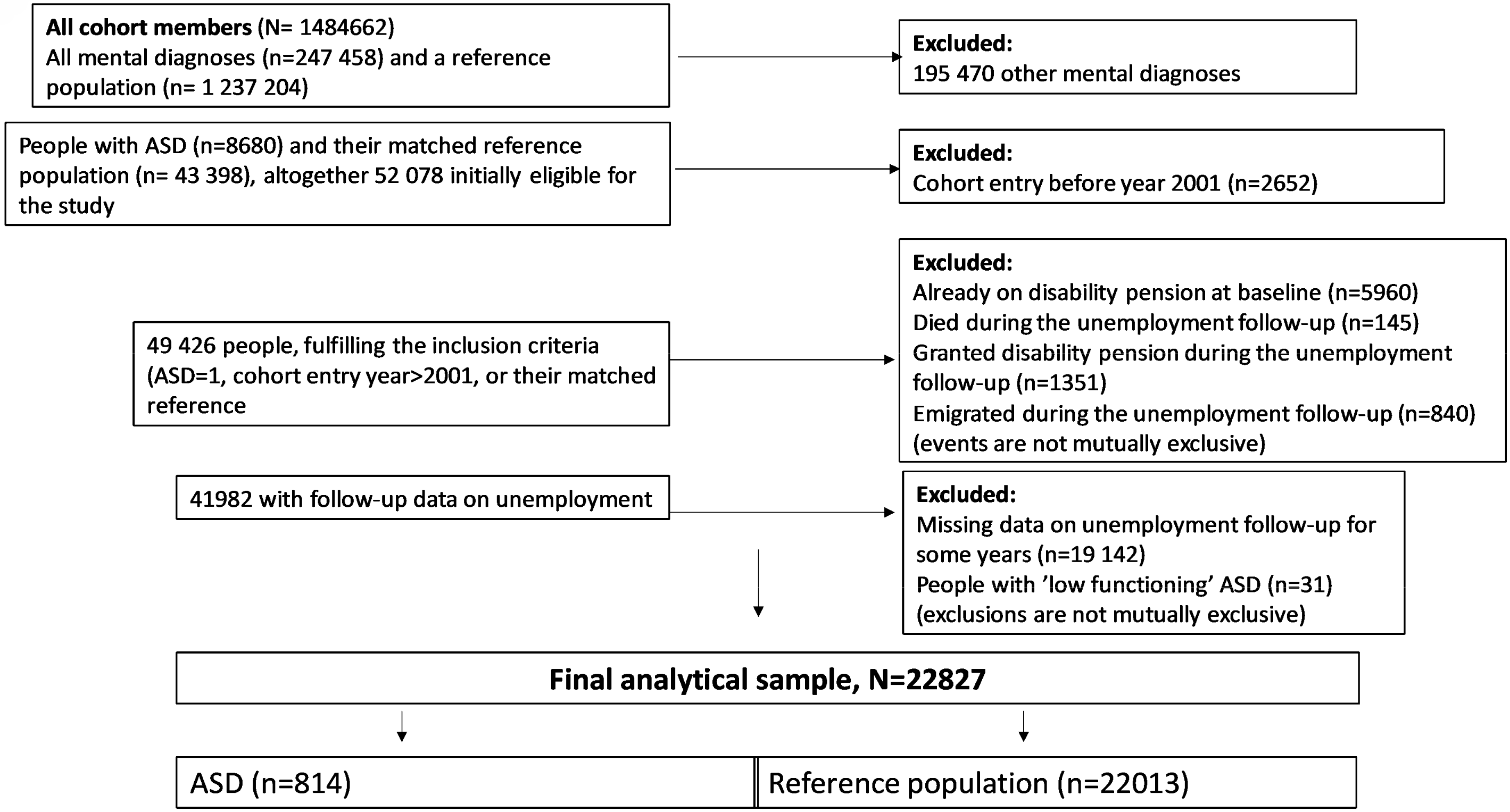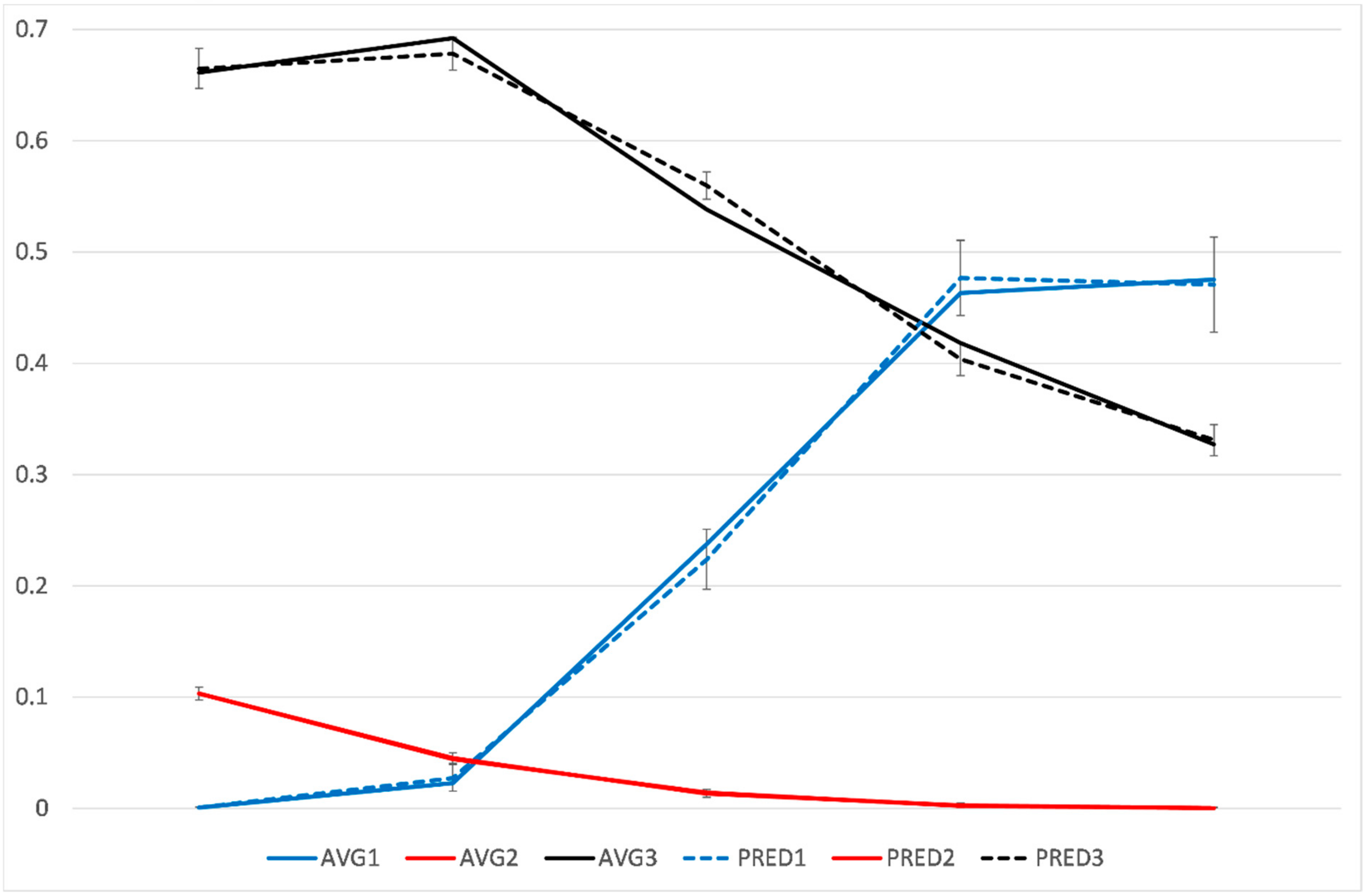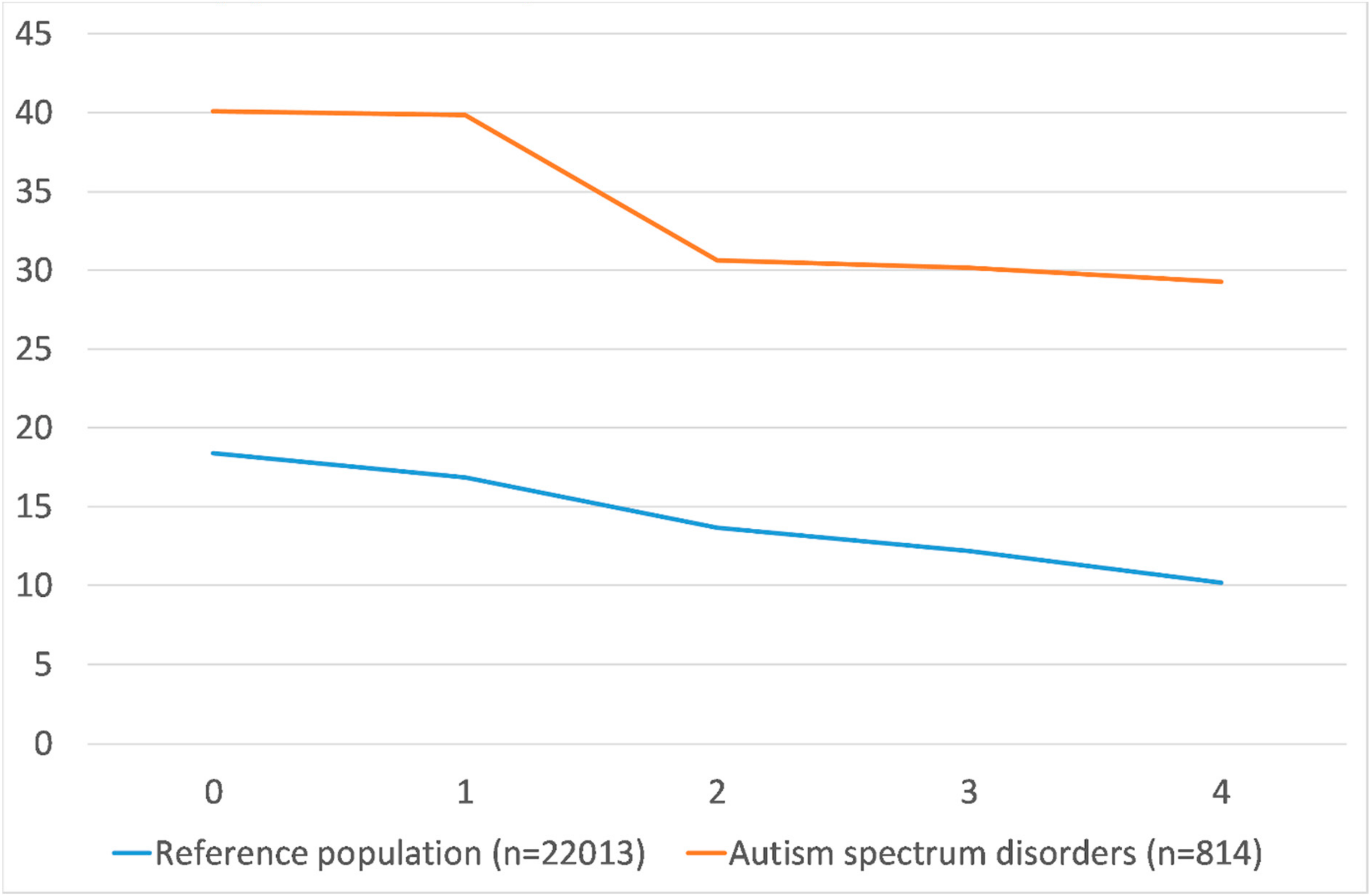Unemployment Trajectories and the Early Risk of Disability Pension among Young People with and without Autism Spectrum Disorder: A Nationwide Study in Sweden
Abstract
1. Introduction
- To identify unemployment trajectories among young adults (aged 19–35), and to examine ASD and social factors as determinants of the future unemployment trajectory memberships.
- To estimate mean number of unemployment days per year among people with ASD, their references, and within the distinct trajectory groups.
- To use the identified trajectories as determinants of the subsequent risk of disability pension, considering the independent effects of ASD.
2. Materials and Methods
2.1. Individuals with Autism Spectrum Disorder and their Matched References from the General Population
2.2. Unemployment Trajectories and Disability Pension Follow-Up
2.3. Covariates
2.4. Statistical Analyses
3. Results
3.1. Descriptive
3.2. Trajectories of Unemployment among People with and without Autism Spectrum Disorder
3.3. Mean Unemployment Days
3.4. Risk of a Disability Pension
4. Discussion
4.1. Main Findings
4.2. Interpretation
4.3. Methodological Considerations
5. Conclusions
Supplementary Materials
Author Contributions
Funding
Conflicts of Interest
References
- Harkko, J.; Virtanen, M.; Kouvonen, A. Unemployment and work disability due to common mental disorders among young adults: Selection or causation? Eur. J. Public Health 2018, 28, 791–797. [Google Scholar] [CrossRef] [PubMed]
- Overland, S. Unemployment and mental health. Occup. Environ. Med. 2016, 73, 717–718. [Google Scholar] [CrossRef] [PubMed]
- Kaspersen, S.L.; Pape, K.; Ose, S.O.; Gunnell, D.; Bjorngaard, J.H. Unemployment and initiation of psychotropic medication: A case-crossover study of 2 348 552 Norwegian employees. Occup. Environ. Med. 2016, 73, 719–726. [Google Scholar] [CrossRef] [PubMed]
- Milner, A.; Page, A.; LaMontagne, A.D. Cause and effect in studies on unemployment, mental health and suicide: A meta-analytic and conceptual review. Psychol. Med. 2014, 44, 909–917. [Google Scholar] [CrossRef]
- Milner, A.; Page, A.; LaMontagne, A.D. Long-term unemployment and suicide: A systematic review and meta-analysis. PLoS ONE 2013, 8, e51333. [Google Scholar] [CrossRef]
- Helgesson, M.; Tinghog, P.; Wang, M.; Rahman, S.; Saboonchi, F.; Mittendorfer-Rutz, E. Trajectories of work disability and unemployment among young adults with common mental disorders. BMC Public Health 2018, 18, 1228-018-6141-y. [Google Scholar] [CrossRef]
- Frank, F.; Jablotschkin, M.; Arthen, T.; Riedel, A.; Fangmeier, T.; Hölzel, L.P.; Tebartz van Elst, L. Education and employment status of adults with autism spectrum disorders in Germany-a cross-sectional-survey. BMC Psychiatry 2018, 18, 75-018-1645-7. [Google Scholar] [CrossRef]
- Ohl, A.; Grice Sheff, M.; Small, S.; Nguyen, J.; Paskor, K.; Zanjirian, A. Predictors of employment status among adults with Autism Spectrum Disorder. Work 2017, 56, 345–355. [Google Scholar] [CrossRef]
- Hayward, S.M.; McVilly, K.R.; Stokes, M.A. Challenges for females with high functioning autism in the workplace: A systematic review. Disabil. Rehabil. 2018, 40, 249–258. [Google Scholar] [CrossRef]
- Howlin, P.; Magiati, I. Autism spectrum disorder: Outcomes in adulthood. Curr. Opin. Psychiatry 2017, 30, 69–76. [Google Scholar] [CrossRef]
- Vogeley, K.; Kirchner, J.C.; Gawronski, A.; Tebartz van Elst, L.; Dziobek, I. Toward the development of a supported employment program for individuals with high-functioning autism in Germany. Eur. Arch. Psychiatry Clin. Neurosci. 2013, 263 (Suppl. 2), S197–S203. [Google Scholar] [CrossRef] [PubMed]
- Hirvikoski, T.; Mittendorfer-Rutz, E.; Boman, M.; Larsson, H.; Lichtenstein, P.; Bolte, S. Premature mortality in autism spectrum disorder. Br. J. Psychiatry 2016, 208, 232–238. [Google Scholar] [CrossRef] [PubMed]
- Nagin, D.S.; Odgers, C.L. Group-based trajectory modeling in clinical research. Annu. Rev. Clin. Psychol. 2010, 6, 109–138. [Google Scholar] [CrossRef] [PubMed]
- Bergman, L.R.; Trost, K. The person-oriented versus the variable-oriented approach: Are they complementary, opposites, or exploring different worlds? Merrill Palmer Q. 2006, 52, 601–634. [Google Scholar] [CrossRef]
- Ludvigsson, J.F.; Svedberg, P.; Olen, O.; Bruze, G.; Neovius, M. The longitudinal integrated database for health insurance and labour market studies (LISA) and its use in medical research. Eur. J. Epidemiol. 2019, 34, 423–437. [Google Scholar] [CrossRef]
- World Health Organization. ICD-10: International Statistical Classification of Diseases and Related Health Problems: Tenth Revision, 2nd ed.; World Health Organization: Geneva, Switzerland, 2004. [Google Scholar]
- Social Insurance in Figures 2018; Swedish Social Insurance Agency: Stockholm, Sweden, 2018.
- Kawa, R.; Saemundsen, E.; Lóa Jónsdóttir, S.; Hellendoorn, A.; Lemcke, S.; Canal-Bedia, R.; García-Primo, P.; Moilanen, I. European studies on prevalence and risk of autism spectrum disorders according to immigrant status-a review. Eur. J. Public Health 2017, 27, 101–110. [Google Scholar] [CrossRef]
- Lallukka, T.; Ervasti, J.; Lundström, E.; Mittendorfer-Rutz, E.; Friberg, E.; Virtanen, M.; Alexanderson, K. Trends in Diagnosis-Specific Work Disability Before and After Stroke: A Longitudinal Population-Based Study in Sweden. J. Am. Heart Assoc. 2018, 7. [Google Scholar] [CrossRef]
- Virtanen, M.; Ervasti, J.; Mittendorfer-Rutz, E.; Lallukka, T.; Kjeldgård, L.; Friberg, E.; Kivimäki, M.; Lundström, E.; Alexanderson, K. Work Disability Before and After a Major Cardiovascular Event: A Ten-Year Study Using Medical and Insurance Registers. Sci. Rep. 2017, 7, 1142. [Google Scholar] [CrossRef]
- Ervasti, J.; Virtanen, M.; Pentti, J.; Lallukka, T.; Tinghög, P.; Kjeldgård, L.; Mittendorfer-Rutz, E.; Alexanderson, K. Work disability before and after diabetes diagnosis: A nationwide population-based register study in Sweden. Am. J. Public Health 2015, 105, e22–e299. [Google Scholar] [CrossRef]
- Jones, B.L.; Nagin, D.S.; Roeder, K. SAS procedure based on mixture models for estimating developmental trajectories. Sociol. Methods Res. 2001, 29, 374–393. [Google Scholar] [CrossRef]
- Cassidy, S.; Bradley, L.; Shaw, R.; Baron-Cohen, S. Risk markers for suicidality in autistic adults. Mol. Autism 2018, 9, 42-018-0226-4. [Google Scholar] [CrossRef] [PubMed]
- Cimera, R.E.; Cowan, R.J. The costs of services and employment outcomes achieved by adults with autism in the US. Autism 2009, 13, 285–302. [Google Scholar] [CrossRef] [PubMed]
- Virtanen, M.; Lallukka, T.; Kivimäki, M.; Alexanderson, K.; Ervasti, J.; Mittendorfer-Rutz, E. Neurodevelopmental disorders among young adults and the risk of sickness absence and disability pension: A nationwide register linkage study. Scand J. Work Environ. Health 2020. [Google Scholar] [CrossRef] [PubMed]
- Wilson, C.E.; Roberts, G.; Gillan, N.; Ohlsen, C.; Robertson, D.; Zinkstok, J. The NICE guideline on recognition, referral, diagnosis and management of adults on the autism spectrum. Adv. Ment. Health Intellect. Disabil. 2014, 8, 3–14. [Google Scholar] [CrossRef]
- National Collaborating Centre for Mental Health (UK). Autism: Recognition, Referral, Diagnosis and Management of Adults on the Autism Spectrum; British Psychological Society: Leicester, UK; Royal College of Psychiatrists: London, UK, 2012. [Google Scholar]
- Pilling, S.; Baron-Cohen, S.; Megnin-Viggars, O.; Lee, R.; Taylor, C. Guideline Development Group. Recognition, referral, diagnosis, and management of adults with autism: Summary of NICE guidance. BMJ 2012, 344, e4082. [Google Scholar]
- Mavranezouli, I.; Megnin-Viggars, O.; Cheema, N.; Howlin, P.; Baron-Cohen, S.; Pilling, S. The cost-effectiveness of supported employment for adults with autism in the United Kingdom. Autism 2014, 18, 975–984. [Google Scholar] [CrossRef]
- Brooke, H.L.; Talbäck, M.; Hörnblad, J.; Johansson, L.A.; Ludvigsson, J.F.; Druid, H.; Feychting, M.; Ljung, R. The Swedish cause of death register. Eur. J. Epidemiol. 2017, 32, 765–773. [Google Scholar] [CrossRef]
- Ludvigsson, J.F.; Almqvist, C.; Bonamy, A.K.E.; Ljung, R.; Michaëlsson, K.; Neovius, M.; Stephansson, O.; Ye, W. Registers of the Swedish total population and their use in medical research. Eur. J. Epidemiol. 2016, 31, 125–136. [Google Scholar] [CrossRef]
- Ludvigsson, J.F.; Andersson, E.; Ekbom, A.; Feychting, M.; Kim, J.L.; Reuterwall, C.; Heurgren, M.; Olausson, P.O. External review and validation of the Swedish national inpatient register. BMC Public Health 2011, 11, 450-2458-11-450. [Google Scholar] [CrossRef]
- Ludvigsson, J.F.; Otterblad-Olausson, P.; Pettersson, B.U.; Ekbom, A. The Swedish personal identity number: Possibilities and pitfalls in healthcare and medical research. Eur. J. Epidemiol. 2009, 24, 659–667. [Google Scholar] [CrossRef]



| Sociodemographics and Trajectory Groups | All (n = 22,827) | Reference Population (n = 22,013), % | ASD (n = 814), % | p-Value (Difference between ASD Individuals and References) | |||
|---|---|---|---|---|---|---|---|
| Frequency | Percent | Frequency | Percent | Frequency | Percent | ||
| Sex | |||||||
| Men | 16049 | 70.3 | 15452 | 70.2 | 597 | 73.3 | |
| Women | 6778 | 29.7 | 6561 | 29.8 | 217 | 26.7 | 0.0537 |
| Educational level | |||||||
| Low | 3520 | 15.4 | 3247 | 14.8 | 273 | 33.5 | |
| Intermediate | 15363 | 67.3 | 14947 | 67.9 | 416 | 51.1 | |
| High | 3944 | 17.3 | 3819 | 17.4 | 125 | 15.4 | <0.0001 |
| Family situation | |||||||
| Married or cohabiting | 2642 | 11.6 | 2605 | 11.8 | 37 | 4.6 | |
| Single or living at home with parents (youth) | 20185 | 88.4 | 19408 | 88.2 | 777 | 95.5 | <0.0001 |
| The type of living area at follow-up start | |||||||
| Big cities | 8204 | 35.9 | 7917 | 36.0 | 287 | 35.3 | |
| Medium-sized cities | 7712 | 33.8 | 7431 | 33.8 | 281 | 34.5 | |
| Rural areas | 6911 | 30.3 | 6665 | 30.3 | 246 | 30.2 | 0.8845 |
| Birth country | |||||||
| Born in Sweden | 21106 | 92.5 | 20,343 | 92.4 | 763 | 93.7 | |
| Born outside Sweden | 1721 | 7.5 | 1670 | 7.6 | 51 | 6.3 | 0.161 |
| Trajectory group | |||||||
| Low, then sharply increasing unemployment | 1883 | 8.3 | 1782 | 8.1 | 101 | 12.4 | |
| Low unemployment (reference) | 16,247 | 71.2 | 15,881 | 72.1 | 366 | 45.0 | |
| High unemployment, then slowly decreasing | 4697 | 20.6 | 4350 | 19.8 | 347 | 42.6 | <0.0001 |
| Autism Spectrum Disorder (ASD) and Sociodemographics | Age- and Sex-Adjusted Models | Fully Adjusted Model | |||||
|---|---|---|---|---|---|---|---|
| Trajectory Group | Odds Ratio | 95% CI | Odds Ratio | 95% CI | |||
| Autism spectrum disorder (ASD) as a determinant of trajectory memberships | Trajectory group | ||||||
| Reference | Low unemployment | 1 | 1 | ||||
| ASD vs. reference population | High then slowly decreasing | 3.60 | 3.08 | 4.19 | 3.23 | 2.75 | 3.79 |
| ASD vs. reference population | Low then sharply increasing | 2.53 | 2.02 | 3.18 | 2.42 | 1.92 | 3.04 |
| Social determinants’ associations with trajectory memberships | |||||||
| Reference | Low unemployment | 1 | 1 | ||||
| Men vs. women | High then slowly decreasing | 1.28 | 1.19 | 1.38 | 1.24 | 1.15 | 1.34 |
| Men vs. women | Low then sharply increasing | 0.98 | 0.88 | 1.08 | 0.97 | 0.87 | 1.08 |
| Reference | Low unemployment | 1 | 1 | ||||
| Age (continuous) | High then slowly decreasing | 0.91 | 0.91 | 0.92 | 0.94 | 0.93 | 0.95 |
| Age (continuous) | Low then sharply increasing | 0.95 | 0.94 | 0.96 | 0.95 | 0.94 | 0.96 |
| Reference | Low unemployment | 1 | 1 | ||||
| Low education vs. high education | High then slowly decreasing | 4.92 | 4.28 | 5.66 | 4.25 | 3.69 | 4.90 |
| Low education vs. high education | Low then sharply increasing | 1.99 | 1.66 | 2.39 | 1.84 | 1.53 | 2.21 |
| Intermediate education vs. high education | High then slowly decreasing | 1.86 | 1.64 | 2.11 | 1.69 | 1.49 | 1.92 |
| Intermediate education vs. high education | Low then sharply increasing | 1.10 | 0.95 | 1.28 | 1.07 | 0.92 | 1.25 |
| Reference | Low unemployment | ||||||
| Medium-sized town vs Large city | High then slowly decreasing | 1.68 | 1.55 | 1.83 | 1.76 | 1.62 | 1.92 |
| Medium-sized town vs Large city | Low then sharply increasing | 1.37 | 1.22 | 1.53 | 1.41 | 1.25 | 1.58 |
| Small town/village vs Large city | High then slowly decreasing | 2.06 | 1.90 | 2.24 | 2.14 | 1.96 | 2.33 |
| Small town/village vs Large city | Low then sharply increasing | 1.25 | 1.11 | 1.41 | 1.30 | 1.15 | 1.46 |
| Reference | Low unemployment | 1 | 1 | ||||
| Born outside Sweden vs. in Sweden | High then slowly decreasing | 1.86 | 1.73 | 2.00 | 1.80 | 1.60 | 2.03 |
| Born outside Sweden vs. in Sweden | Low then sharply increasing | 1.31 | 1.18 | 1.45 | 1.71 | 1.45 | 2.02 |
| Crude Model (Model 0) | Age- and ASD-Adjusted Model (Model 1) | Fully Adjusted Model (Model 2) | |||||||
|---|---|---|---|---|---|---|---|---|---|
| Total population | HR | 95% CI | HR | 95% CI | HR | 95% CI | |||
| Trajectory group | |||||||||
| Low unemployment (reference) | 1.00 | 1.00 | 1.00 | ||||||
| High then slowly decreasing | 6.70 | 4.27 | 10.51 | 2.77 | 1.75 | 4.39 | 2.52 | 1.58 | 4.02 |
| Low then sharply increasing | 4.58 | 2.47 | 8.48 | 2.28 | 1.23 | 4.24 | 2.00 | 1.07 | 3.74 |
| Autism spectrum disorder (own effect) | |||||||||
| No | 1.00 | 1.00 | |||||||
| Yes | 92.72 | 57.12 | 150.51 | 83.71 | 51.23 | 136.77 | |||
© 2020 by the authors. Licensee MDPI, Basel, Switzerland. This article is an open access article distributed under the terms and conditions of the Creative Commons Attribution (CC BY) license (http://creativecommons.org/licenses/by/4.0/).
Share and Cite
Lallukka, T.; Mittendorfer-Rutz, E.; Ervasti, J.; Alexanderson, K.; Virtanen, M. Unemployment Trajectories and the Early Risk of Disability Pension among Young People with and without Autism Spectrum Disorder: A Nationwide Study in Sweden. Int. J. Environ. Res. Public Health 2020, 17, 2486. https://doi.org/10.3390/ijerph17072486
Lallukka T, Mittendorfer-Rutz E, Ervasti J, Alexanderson K, Virtanen M. Unemployment Trajectories and the Early Risk of Disability Pension among Young People with and without Autism Spectrum Disorder: A Nationwide Study in Sweden. International Journal of Environmental Research and Public Health. 2020; 17(7):2486. https://doi.org/10.3390/ijerph17072486
Chicago/Turabian StyleLallukka, Tea, Ellenor Mittendorfer-Rutz, Jenni Ervasti, Kristina Alexanderson, and Marianna Virtanen. 2020. "Unemployment Trajectories and the Early Risk of Disability Pension among Young People with and without Autism Spectrum Disorder: A Nationwide Study in Sweden" International Journal of Environmental Research and Public Health 17, no. 7: 2486. https://doi.org/10.3390/ijerph17072486
APA StyleLallukka, T., Mittendorfer-Rutz, E., Ervasti, J., Alexanderson, K., & Virtanen, M. (2020). Unemployment Trajectories and the Early Risk of Disability Pension among Young People with and without Autism Spectrum Disorder: A Nationwide Study in Sweden. International Journal of Environmental Research and Public Health, 17(7), 2486. https://doi.org/10.3390/ijerph17072486






